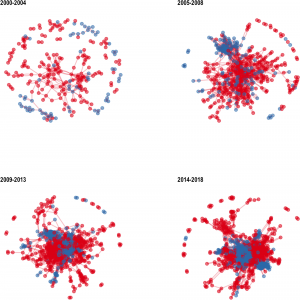
~15 years after the first project was funded, the Sloan “Microbiology of the Built Environment” program has pretty much wrapped up. Here at microBEnet, we wanted to take a deeper look at the impact of the program on the published literature in the field. There were over 300 publications from the program through the end of 2017 when we started our analysis (many more since, but those will have to wait for another look). Some of you may recall our microBEnet posts asking for additional entries for that dataset. Network analysis is a bit outside our wheelhouse, but we teamed up with a couple of data scientists employed the UC Davis Library… Dan Hicks and Carl Stahmer.
The results of that collaboration were published a few months ago in our article “Network analysis to evaluate the impact of research funding on research community consolidation”.
The cliff notes version is that there appeared to be more consolidation between researchers within the Sloan-funded community than in a control group of researchers who published in the same journals. Not really a surprise, but good to actually see! In particular we see a lot more collaborations between building science folks and microbiology folks (we couldn’t really get into this in the paper because the difficulty of classifying researchers). That kind of cross-disciplinary collaboration seems great for both fields.
Abstract below:
“In 2004, the Alfred P. Sloan Foundation launched a new program focused on incubating a new field, “Microbiology of the Built Environment” (MoBE). By the end of 2017, the program had supported the publication of hundreds of scholarly works, but it was unclear to what extent it had stimulated the development of a new research community. We identified 307 works funded by the MoBE program, as well as a comparison set of 698 authors who published in the same journals during the same period of time but were not part of the Sloan Foundation-funded collaboration. Our analysis of collaboration networks for both groups of authors suggests that the Sloan Foundation’s program resulted in a more consolidated community of researchers, specifically in terms of number of components, diameter, density, and transitivity of the coauthor networks. In addition to highlighting the success of this particular program, our method could be applied to other fields to examine the impact of funding programs and other large-scale initiatives on the formation of research communities.”